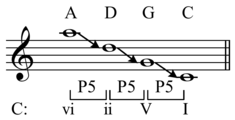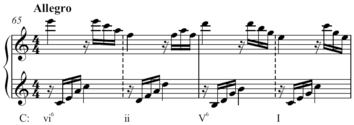vi–ii–V–I
In music, the vi–ii–V–I progression is a chord progression (also called the circle progression for the circle of fifths, along which it travels). A vi–ii–V–I progression in C major (with inverted chords) is shown below.[1]
It is "undoubtedly the most common and the strongest of all harmonic progressions" and consists of "adjacent roots in ascending fourth or descending fifth relationship", with movement by ascending perfect fourth being equivalent to movement by descending perfect fifth due to inversion.[2] For instance, in C major, the chords are Am–Dm–G–C, which have roots that descend by perfect fifth (or ascend by fourth), as shown below.[3]
The circle progression is commonly a succession through all seven diatonic chords of a diatonic scale by fifths, including one progression by diminished fifth, (in C: between F and B♮) and one diminished chord (in C major, Bo), returning to the tonic at the end. A circle progression in C major is shown below.
Shorter progressions may be derived from this by selecting certain specific chords from the progression through all seven diatonic chords.[2] The ii–V–I turnaround lies at the end of the circle progression, as does the vi–ii–V–I progression of root movement by descending fifths, which establishes tonality and also strengthens the key through the contrast of minor and major.[3]
Examples
Examples of vi–ii–V–I are shown below.
I−vi−ii−V
I−vi−ii−V is one of the most common chord progressions in jazz.[5] The progression is often used[6] as a turnaround, occurring as the last two bars of a chorus or section.[7] The I−vi−ii−V chord progression occurs as a two-bar pattern in the A section of the rhythm changes,[8] the progression based on George Gershwin's "I Got Rhythm". It can be varied as well: according to Mark Levine, "[t]oday's players usually play a dominant 7th chord rather than a minor 7th chord as the VI chord in a I-VI-II-V."[5]
In the jazz minor scale, the diatonic progression below is possible.[9]
See also
Sources
- Andrews, William G; Sclater, Molly (2000). Materials of Western Music Part 1, p.226. ISBN 1-55122-034-2.
- Bruce Benward and Marilyn Nadine Saker, Music In Theory and Practice, seventh edition, 2 vols. + 2 sound discs (Boston: McGraw-Hill, 2003) 1:178. ISBN 978-0-07-294262-0.
- William G Andrews and Molly Sclater (2000). Materials of Western Music Part 1, p.227. ISBN 1-55122-034-2.
- Jonas, Oswald (1982). Introduction to the Theory of Heinrich Schenker, p.26 (1934: Das Wesen des musikalischen Kunstwerks: Eine Einführung in Die Lehre Heinrich Schenkers). Trans. John Rothgeb. ISBN 0-582-28227-6.
- Levine, Mark (1995). The Jazz Theory Book. Petaluma, CA: Sher Music Co. pp. 25. ISBN 1883217040. OCLC 34280067.
- Moore, Alan F. (2002). "XII". The Cambridge Companion to Blues and Gospel Music. Cambridge, UK: Cambridge University Press. p. 126.
- Strunk, Steven (2007), "Harmony", in Kernfeld, Barry (ed.), The New Grove Dictionary of Jazz;, 2nd Edition, New York: Oxford University Press
- DeVeaux, Scott Knowles (1997). The Birth of Bebop: a Social and Musical History. Berkeley: University of California Press. p. 310.
- Arnold, Bruce E. (2001). Music Theory Workbook for Guitar: Scale Construction, p.12. ISBN 978-1-890944-53-7.


